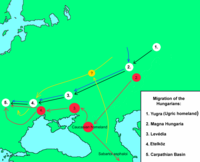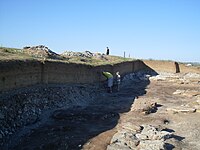| Sarkel | |
|---|---|
| Native name Sharkil | |
|
[[File:{{{image_name}}}|240x240px|Aerial photo of the excavations conducted at Sarkel in the 1930s.]] Aerial photo of the excavations conducted at Sarkel in the 1930s. | |
| Type | Fortification |
| Location | Russia |
| Built | 830s |

Migration of Hungarians

Turkic Tamgas on some of the bricks from Sarkel

Excavations in 2009

Excavations in 2009

Excavations in 2009

Excavations in 2009

Excavations in 2009
Sarkel (or Sharkil, literally white house in Khazar language)[1] was a large limestone-and-brick fortress built by the Khazars with Byzantine assistance in the 830s. It was named white-house because of the white limestone bricks they have used to build Sarkel. Sarkel was located on the left bank of the lower Don River, in present-day Rostov Oblast of Russia.
Construction[]
Sarkel was built to protect the north-western border of the Khazar state in 833. The Khazars asked their ally, Byzantine emperor Theophilus, for engineers to build a fortified capital, and Theophilus sent his chief engineer Petronas Kamateros. In recompense for these services, the Khazar khagan ceded Chersonesos and some other Crimean dependencies to Byzantium.
Historians have been unable to determine why such a strong fortress was built on the Don. They generally assert that the costly construction must have been due to the rise of a strong regional power that posed a threat to the Khazars. Alexander Vasiliev and George Vernadsky, among others, argue that Sarkel was built to defend a vital portage between the Don and the Volga from the Rus' Khaganate. Other historians believe this polity was situated many hundred miles to the north. Another nascent power, the Hungarians, was not particularly threatening to the Khazars as long as they paid tribute to the khagan.
Constantine Porphyrogenitus records in his work De Administrando Imperio that the Khazars asked the Emperor Teophilos to have the fortress of Sarkel built for them. His record is connected to the Hungarians on the basis that the new fortress must have become necessary because of the appearance of a new enemy of the Khazars, and other peoples could not be taken into account as the Khazars’ enemies at that time. In the 10th century, a Persian explorer and geographer Ahmad ibn Rustah mentioned that the Khazars entrenched themselves against the attacks of the Hungarians.
History[]

Principalities of Kievan Rus' (1054-1132).
The city served as a bustling commercial center, as it controlled the Volga-Don portage, which was used by the Rus to cross from the Black Sea to the Volga and thence to the Caspian; the route was known as the "Khazarian Way". A garrison fortified at Sarkel included Oghuz and Pecheneg mercenaries.
Sarkel's fortress and city were captured by Kievan Rus' under prince Sviatoslav I in 965. The city was renamed Bila Vezha (Slavic for White Tower or White Fortress) and settled by Slavs. It remained Slavic until the 12th century, when the district was taken over by the Kipchaks.
Mikhail Artamonov excavated the site in the 1930s. It was the most ambitious excavation of a Khazar site ever undertaken. Among many Khazar and Rus items, Artamonov discovered Byzantine columns used in the construction of Sarkel. The site is now submerged by the Tsimlyansk Reservoir, so no further excavations may be conducted.
See also[]
- Samosdelka
Notes[]
- ↑ D. Dunlop, The History of the Jewish Khazars, Princeton University Press (1954). According to Károly Cseglédy, "Šarkel: An Ancient Turkish Word for 'House'" in D.Sinor, ed., Aspects of Altaic Culture (Uralic and Altaic studies no. 23) (Bloomington and the Hague, 1963), pp. 23-31, shar is related to Chuvash shura 'white' and kel/kil is borrowed from Middle Persian gil 'house.'
References[]
- Dunlop, Douglas Morton (1997). "Sarkel". Encyclopaedia Judaica (CD-ROM Edition Version 1.0). Ed. Cecil Roth. Keter Publishing House. ISBN 965-07-0665-8
- Grousset, René (1970). The Empire of the Steppes: A History of Central Asia. (transl. Naomi Walford). New Brunswick, New Jersey: Rutgers University Press. ISBN 0-8135-0627-1
- Dunlop, Douglas M. (1954). The History of the Jewish Khazars. Princeton, N.J.: Princeton University Press.
- Brook, Kevin Alan (2006). The Jews of Khazaria. 2nd ed. Rowman & Littlefield Publishers, Inc. ISBN 0-7425-4981-X
- Koestler, Arthur (1976). The Thirteenth Tribe Hutchinson. ISBN 0-394-40284-7
- Vernadsky, George. A History of Russia. (online)
External links[]
The original article can be found at Sarkel and the edit history here.